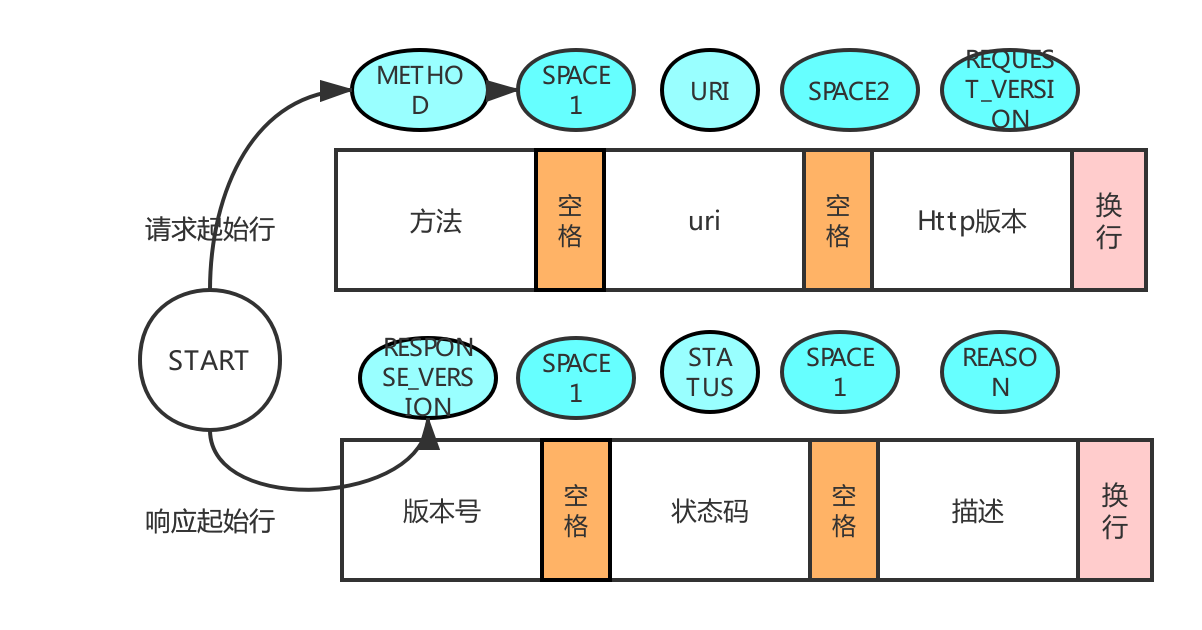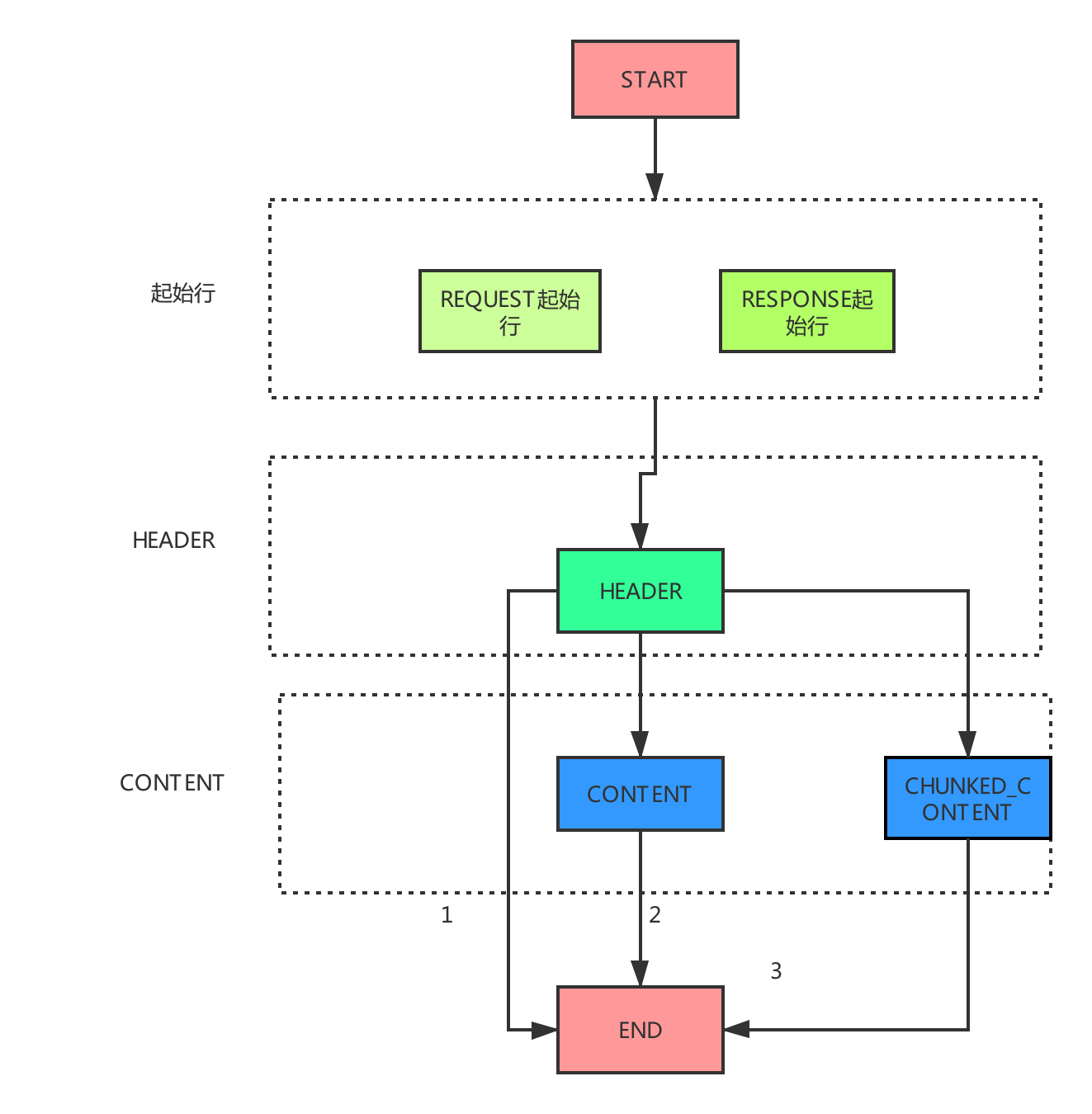詳解http報文(2)-web容器是如何解析http報文的
- 2019 年 10 月 9 日
- 筆記
摘要
在詳解http報文一文中,詳細介紹了http報文的文本結構。那麼作為服務端,web容器是如何解析http報文的呢?本文以jetty和undertow容器為例,來解析web容器是如何處理http報文的。
在前文中我們從概覽中可以了解到,http報文其實就是一定規則的字符串,那麼解析它們,就是解析字符串,看看是否滿足http協議約定的規則。
start-line: 起始行,描述請求或響應的基本信息 *( header-field CRLF ): 頭 CRLF [message-body]: 消息body,實際傳輸的數據 jetty
以下代碼都是jetty9.4.12版本
如何解析這麼長的字符串呢,jetty是通過狀態機來實現的。具體可以看下org.eclipse.jetty.http.HttpParse類
public enum State { START, METHOD, , SPACE1, STATUS, URI, SPACE2, REQUEST_VERSION, REASON, PROXY, HEADER, CONTENT, EOF_CONTENT, CHUNKED_CONTENT, CHUNK_SIZE, CHUNK_PARAMS, CHUNK, TRAILER, END, CLOSE, // The associated stream/endpoint should be closed CLOSED // The associated stream/endpoint is at EOF }總共分成了21種狀態,然後進行狀態間的流轉。在parseNext方法中分別對起始行 -> header -> body content分別解析
public boolean parseNext(ByteBuffer buffer) { try { // Start a request/response if (_state==State.START) { // 快速判斷 if (quickStart(buffer)) return true; } // Request/response line 轉換 if (_state.ordinal()>= State.START.ordinal() && _state.ordinal()<State.HEADER.ordinal()) { if (parseLine(buffer)) return true; } // headers轉換 if (_state== State.HEADER) { if (parseFields(buffer)) return true; } // content轉換 if (_state.ordinal()>= State.CONTENT.ordinal() && _state.ordinal()<State.TRAILER.ordinal()) { // Handle HEAD response if (_responseStatus>0 && _headResponse) { setState(State.END); return handleContentMessage(); } else { if (parseContent(buffer)) return true; } } return false; }整體流程
整體有三條路徑
- 開始 -> start-line -> header -> 結束
- 開始 -> start-line -> header -> content -> 結束
- 開始 -> start-line -> header -> chunk-content -> 結束

起始行
start-line = request-line(請求起始行)/(響應起始行)status-line

-
請求報文解析狀態遷移
請求行:START -> METHOD -> SPACE1 -> URI -> SPACE2 -> REQUEST_VERSION -
響應報文解析狀態遷移
響應行:START -> RESPONSE_VERSION -> SPACE1 -> STATUS -> SPACE2 -> REASON
header 頭
HEADER 的狀態只有一種了,在jetty的老版本中還區分了HEADER_IN_NAM, HEADER_VALUE, HEADER_IN_VALUE等,9.4中都去除了。為了提高匹配效率,jetty使用了Trie樹快速匹配header頭。
static { CACHE.put(new HttpField(HttpHeader.CONNECTION,HttpHeaderValue.CLOSE)); CACHE.put(new HttpField(HttpHeader.CONNECTION,HttpHeaderValue.KEEP_ALIVE)); // 以下省略了很多了通用header頭content
請求體:
- CONTENT -> END,這種是普通的帶Content-Length頭的報文,HttpParser一直運行CONTENT狀態,直到最後ContentLength達到了指定的數量,則進入END狀態
- chunked分塊傳輸的數據
CHUNKED_CONTENT -> CHUNK_SIZE -> CHUNK -> CHUNK_END -> END
undertow
undertow是另一種web容器,它的處理方式與jetty有什麼不同呢
狀態機種類不一樣了,io.undertow.util.HttpString.ParseState
public static final int VERB = 0; public static final int PATH = 1; public static final int PATH_PARAMETERS = 2; public static final int QUERY_PARAMETERS = 3; public static final int VERSION = 4; public static final int AFTER_VERSION = 5; public static final int HEADER = 6; public static final int HEADER_VALUE = 7; public static final int PARSE_COMPLETE = 8;具體處理流程在HttpRequestParser抽象類中
public void handle(ByteBuffer buffer, final ParseState currentState, final HttpServerExchange builder) throws BadRequestException { if (currentState.state == ParseState.VERB) { //fast path, we assume that it will parse fully so we avoid all the if statements // 快速處理GET final int position = buffer.position(); if (buffer.remaining() > 3 && buffer.get(position) == 'G' && buffer.get(position + 1) == 'E' && buffer.get(position + 2) == 'T' && buffer.get(position + 3) == ' ') { buffer.position(position + 4); builder.setRequestMethod(Methods.GET); currentState.state = ParseState.PATH; } else { try { handleHttpVerb(buffer, currentState, builder); } catch (IllegalArgumentException e) { throw new BadRequestException(e); } } // 處理path handlePath(buffer, currentState, builder); // 處理版本 if (failed) { handleHttpVersion(buffer, currentState, builder); handleAfterVersion(buffer, currentState); } // 處理header while (currentState.state != ParseState.PARSE_COMPLETE && buffer.hasRemaining()) { handleHeader(buffer, currentState, builder); if (currentState.state == ParseState.HEADER_VALUE) { handleHeaderValue(buffer, currentState, builder); } } return; } handleStateful(buffer, currentState, builder); }與jetty不同的是對content的處理,在header處理完以後,將數據放到io.undertow.server.HttpServerExchange,然後根據類型,有不同的content讀取方式,比如處理固定長度的,FixedLengthStreamSourceConduit。

關注公眾號【方丈的寺院】,第一時間收到文章的更新,與方丈一起開始技術修行之路

參考
http://www.blogjava.net/DLevin/archive/2014/04/19/411673.html
https://www.ph0ly.com/2018/10/06/jetty/connection/http-parser/
https://webtide.com/http-trailers-in-jetty/
http://undertow.io/undertow-docs/undertow-docs-2.0.0/
